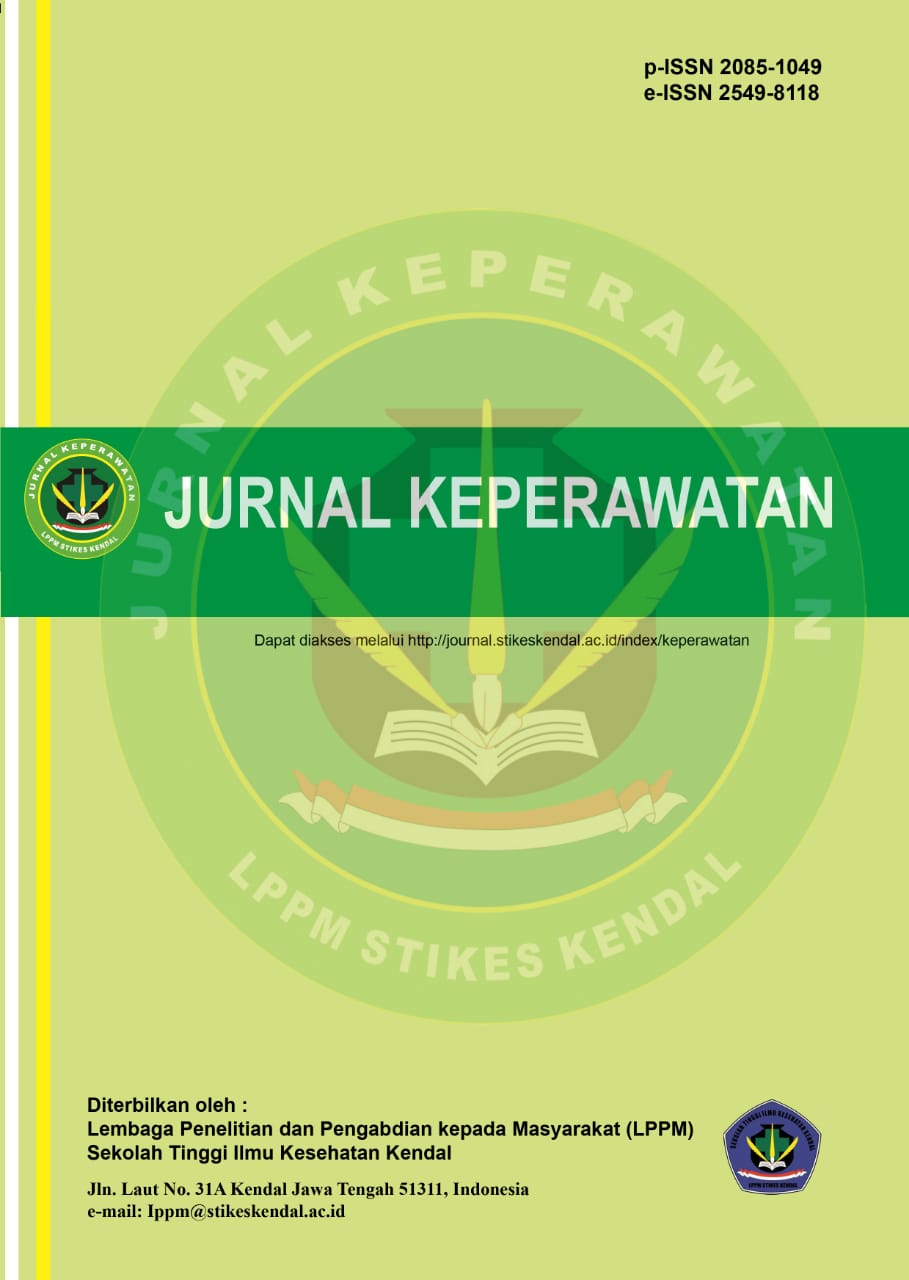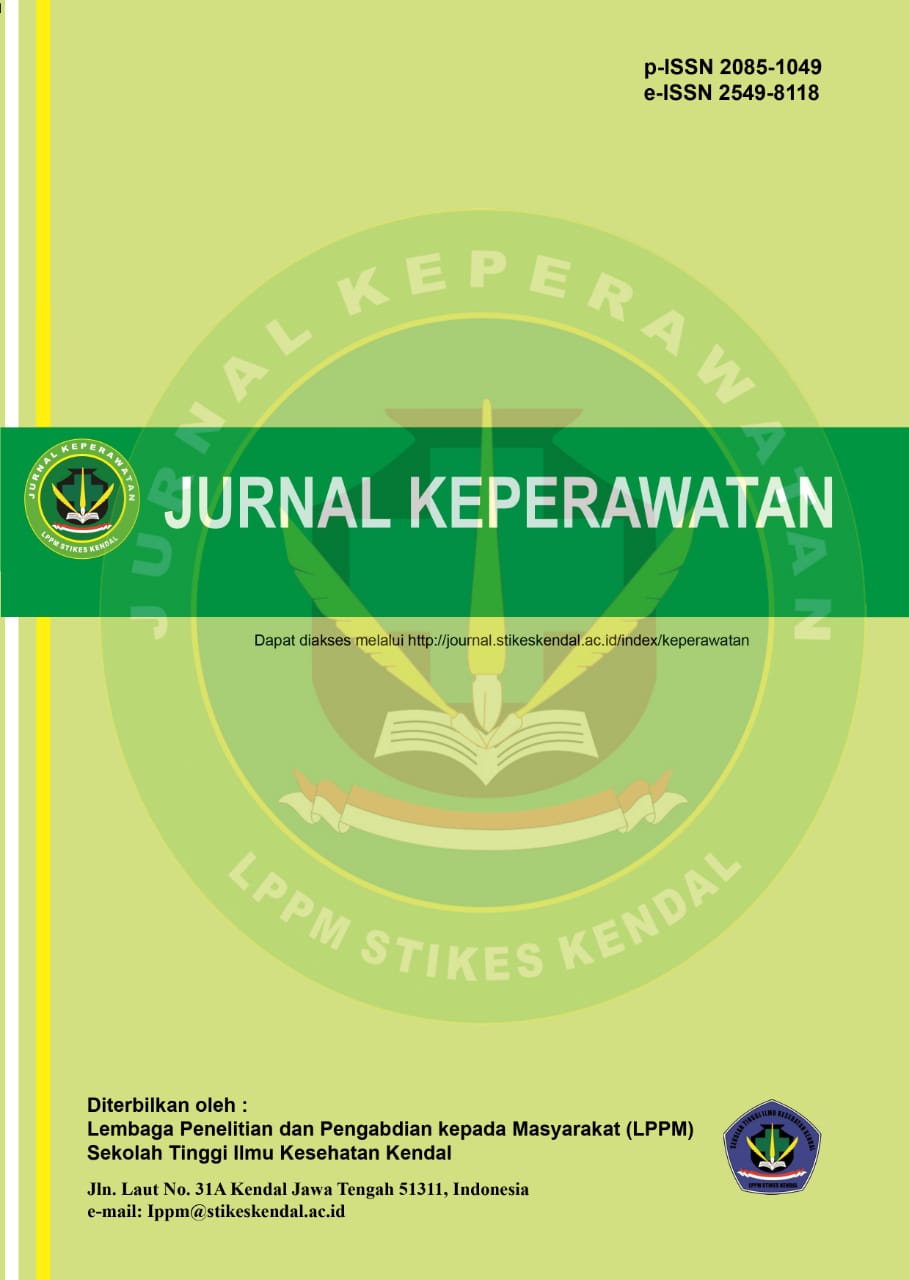Pemberian Perawatan Palliative pada Pasien yang Mengalami End of Life di Instalasi Gawat Darurat: A Scoping Review
DOI:
https://doi.org/10.32583/keperawatan.v16i2.1553Keywords:
end of life, instalasi gawat darurat, perawatan paliatifAbstract
Instalasi Gawat Darurat (IGD) adalah unit yang selalu dikunjungi oleh berbagai jenis pasien mulai dari pasien dengan penyakit akut dan kronis maupun pasien dengan kondisi menjelang akhir (end of life [EoL]). Penanganan kondisi pasien yang memerlukan perawatan paliatif di IGD menjadi tantangan sendiri bagi tenaga Kesehatan. Tujuan penelitian ini adalah untuk mengeksplorasi dan mengidentifikasi kriteria inklusi untuk pasien dengan EoL yang mendapatkan pelayanan di IGD. Identifikasi difokuskan untuk mencari macam-macam domain perawatan paliatif dan jenis tindakan yang diberikan di IGD. Scoping review telah dilakukan dengan menggunakan database ProQuest, Scopus, Science Direct, Cochrance. Literatur utama yang digunakan pada studi ini berjumlah 10 artikel yang telah disintesis oleh peneliti. Temuan penelitian ini menunjukkan empat domain perawatan paliatif, meliputi penanganan fisiologis, psikologis, sosial dan spiritual. Perawatan paliatif berfokus pada pendekatan holistik, transkultural, komprehensif dan berpusat pada pasien, sehingga mendukung model biopsikososial-spiritual yang disajikan sebagai reaksi untuk mengatasi permasalahan pasien baik secara fisik, psikologis, sosial maupun spiritual. Pengetahuan dan sikap yang baik dalam memberikan perawatan paliatif kepada pasien EoL yang mengunjungi IGD menjadi kemampuan penting bagi perawat IGD. Tidak hanya menangani secara fisiologis, tetapi juga meliputi psikososial dan spiritual dalam perawatan paliatif di IGD, sehingga tercapai pelayanan yang optimal dan menyeluruh.
References
Abbaspour, H., & Heydari, A. (2022). Concept Analysis of End-of-Life Care. Journal of Caring Sciences, 11(3), 172–177. https://doi.org/10.34172/jcs.2022.037
Ai, A. L., Hopp, F., Tice, T. N., & Koenig, H. (2013). Existential relatedness in light of eudemonic well-being and religious coping among middle-aged and older cardiac patients. Journal of Health Psychology, 18(3), 368–382. https://doi.org/10.1177/1359105311434754
A’la, M. Z., Farikhah, Z., & Hakam, M. (2020). Nurses’ Attitude Toward End of Life Care in Emergency Departement and Intensive Care Unit In Rural Hospital. IJNP (Indonesian Journal of Nursing Practices), 4(1), 14–20. https://doi.org/10.18196/ijnp.41103
Alqahtani, A. J., & Mitchell, G. (2019). End-of-life care challenges from staff viewpoints in emergency departments: Systematic review. Healthcare (Switzerland), 7(3). https://doi.org/10.3390/healthcare7030083
Ano, G. G., & Vasconcelles, E. B. (2005). Religious coping and psychological adjustment to stress: A meta-analysis. Journal of Clinical Psychology, 61(4), 461–480. https://doi.org/10.1002/jclp.20049
Astuti, N. L. S. (2020). The Effect of Passive Physiotherapy on Hemodynamic Status of Patients with Head Injury: A Literature Review Universitas Gadjah Mada Yogyakarta 7 STIKes Surya Global Yogyakarta. February, 13–14.
Barbera, L., Taylor, C., & Dudgeon, D. (2010). Why do patients with cancer visit the emergency department near the end of life? Canadian Medical Association Journal, 182(6), 563–568. https://doi.org/10.1503/cmaj.091187
Bekke-Hansen, S., Pedersen, C. G., Thygesen, K., Christensen, S., Waelde, L. C., & Zachariae, R. (2014). The role of religious faith, spirituality and existential considerations among heart patients in a secular society: Relation to depressive symptoms 6 months post acute coronary syndrome. Journal of Health Psychology, 19(6), 740–753. https://doi.org/10.1177/1359105313479625
Brickey, J., Flannery, M., Cuthel, A., Cho, J., Grudzen, C. R., Blaum, C., Southerland, L., Bischof, J., Ouchi, K., Elie, M. C., Swor, R., Jubanyik, K., Goldfeld, K. S., Cohen, S. E., Kim, A., Lowy, J., Scherer, J. S., Bael, N. E., Gafford, E., … Navarro, M. (2022). Barriers to recruitment into emergency department-initiated palliative care: a sub-study of a multi-site, randomized controlled trial. BMC Palliative Care, 21(1), 1–9. https://doi.org/10.1186/s12904-021-00899-9
Chan, G. K. (2011). Trajectories of approaching death in the emergency department: Clinician narratives of patient transitions to the end of life. Journal of Pain and Symptom Management, 42(6), 864–881. https://doi.org/10.1016/j.jpainsymman.2011.02.023
Chen, C. Y., Naessens, J. M., Takahashi, P. Y., McCoy, R. G., Borah, B. J., Borkenhagen, L. S., Kimeu, A. K., Rojas, R. L., Johnson, M. G., Visscher, S. L., Cha, S. S., Thorsteinsdottir, B., & Hanson, G. J. (2018). Improving Value of Care for Older Adults With Advanced Medical Illness and Functional Decline: Cost Analyses of a Home-Based Palliative Care Program. Journal of Pain and Symptom Management, 56(6), 928–935. https://doi.org/10.1016/j.jpainsymman.2018.08.015
Christ, M., Grossmann, F., Winter, D., Bingisser, R., & Platz, E. (2010). Modern Triage In The Emergency Department. Deutsches Arzteblatt, 107(50), 892–898. https://doi.org/10.3238/arztebl.2010.0892
Cooper, E., Hutchinson, A., & Sheikh, Z. (2018). Palliative Care in the Emergency Department: A Systematic Literature Qualitative Review and Thematic Synthesi. 27(434), 327–331.
Cornillon, P., Loiseau, S., Aublet-Cuvelier, B., & Guastella, V. (2016). Reasons for transferral to emergency departments of terminally ill patients - A French descriptive and retrospective study. BMC Palliative Care, 15(1), 1–9. https://doi.org/10.1186/s12904-016-0155-y
Crombeen, A. M., & Lilly, E. J. (2020). Management of Dyspnea in Palliative Care. Current Oncology, 27(3), 142–145. https://doi.org/10.3747/co.27.6413
Delgado-Guay, M. O., Kim, Y. J., Shin, S. H., Chisholm, G., Williams, J., Allo, J., & Bruera, E. (2015). Avoidable and Unavoidable Visits to the Emergency Department Among Patients With Advanced Cancer Receiving Outpatient Palliative Care. Journal of Pain and Symptom Management, 49(3), 497–504. https://doi.org/10.1016/j.jpainsymman.2014.07.007
Economos, G., Cavalli, P., Guérin, T., Filbet, M., & Perceau-Chambard, E. (2019). Quality of end-of-life care in the emergency department. Turkish Journal of Emergency Medicine, 19(4), 141–145. https://doi.org/10.1016/j.tjem.2019.09.003
Edwards, A., Pang, N., Shiu, V., & Chan, C. (2010). The understanding of spirituality and the potential role of spiritual care in end-of-life and palliative care: a meta-study of qualitative research. Palliative Medicine, 24(8), 753–770. https://doi.org/10.1177/0269216310375860
Estacio, E. V., Murray, M., & Marks, D. F. (2018). Health Psychology: Theory, Research and Practice. Health Psychology, 1–832.
Grudzen, C. R., Hwang, U., Cohen, J. A., Fischman, M., & Morrison, R. S. (2012). Characteristics of Emergency Department Patients Who Receive a Palliative Care Consultation. Journal of Palliative Medicine, 15(4), 396–399. https://doi.org/10.1089/jpm.2011.0376
Grudzen, C. R., Richardson, L. D., Hopper, S. S., Ortiz, J. M., Whang, C., & Morrison, R. S. (2012). Does palliative care have a future in the emergency department? Discussions with attending emergency physicians. Journal of Pain and Symptom Management, 43(1), 1–9. https://doi.org/10.1016/j.jpainsymman.2011.03.022
Hagan, T. L., Xu, J., Lopez, R. P., & Bressler, T. (2018). Nursing’s role in leading palliative care: A call to action. Nurse Education Today, 61, 216–219. https://doi.org/10.1016/j.nedt.2017.11.037
Kavakli, O. (2016). Two Examples of Nursing Working System in Emergency Medical Services. Eurasian Journal of Emergency Medicine, 15(1), 44–47. https://doi.org/10.5152/eajem.2016.78557
Kim, K., Chakravarthy, B., Anderson, C., & Liao, S. (2017). To Intubate or Not to Intubate: Emergency Medicine Physicians’ Perspective on Intubating Critically Ill, Terminal Cancer Patients. Journal of Pain and Symptom Management, 54(5), 654-660.e1. https://doi.org/10.1016/j.jpainsymman.2017.07.038
Kraus, C. K., Greenberg, M. R., Ray, D. E., & Dy, S. M. (2016). Palliative Care Education in Emergency Medicine Residency Training: A Survey of Program Directors, Associate Program Directors, and Assistant Program Directors. Journal of Pain and Symptom Management, 51(5), 898–906. https://doi.org/10.1016/j.jpainsymman.2015.12.334
Krawczyk, M., & Gallagher, R. (2016). Communicating prognostic uncertainty in potential end-of-life contexts: Experiences of family members. BMC Palliative Care, 15(1), 1–8. https://doi.org/10.1186/s12904-016-0133-4
Kurniawan, D., Setiyarini, S., & Kristanti, M. S. (2019). Pengaruh self-selected individual music therapy (selimut) terhadap perubahan status hemodinamik pasien kanker paliatif di rsup dr. Sardjito yogyakarta. Jurnal Kesehatan Mesencephalon, 5(2). https://doi.org/10.36053/mesencephalon.v5i2.111
Leo, S. Di, Alquati, S., Autelitano, C., Costantini, M., Martucci, G., Vincenzo, F. De, Kuczynska, B., Morini, A., Trabucco, L., Ursicelli, R., Catania, G., & Ghirotto, L. (2019). Palliative care in the emergency department as seen by providers and users : a qualitative study. 1–11.
Long, D. A., Koyfman, A., & Long, B. (2020). Oncologic Emergencies-Palliative Care in the Emergency Department Setting.
Moss, E. L., & Dobson, K. S. (2006). Psychology, spirituality, and end-of-life care: An ethical integration? Canadian Psychology / Psychologie Canadienne, 47(4), 284–299. https://doi.org/10.1037/co2006019
Murray, S. A., Kendall, M., Boyd, K., Worth, A., & Benton, T. F. (2003). General practitioners and their possible role in providing spiritual care: a qualitative study. The British Journal of General Practice : The Journal of the Royal College of General Practitioners, 53(497), 957–959.
Murray, S. A., Kendall, M., Boyd, K., Worth, A., & Benton, T. F. (2004). Exploring the spiritual needs of people dying of lung cancer or heart failure: a prospective qualitative interview study of patients and their carers. Palliative Medicine, 18(1), 39–45. https://doi.org/10.1191/0269216304pm837oa
Ouchi, K., Jambaulikar, G. D., Hohmann, S., George, N. R., Aaronson, E. L., Sudore, R., Schonberg, M. A., Tulsky, J. A., Schuur, J. D., & Pallin, D. J. (2018). Prognosis After Emergency Department Intubation to Inform Shared Decision-Making. Journal of the American Geriatrics Society, 66(7), 1377–1381. https://doi.org/10.1111/jgs.15361
Phelps, A. C. (2009). Religious Coping and Use of Intensive Life-Prolonging Care Near Death in Patients With Advanced Cancer. JAMA, 301(11), 1140. https://doi.org/10.1001/jama.2009.341
Platt, M. (2010). Pain Challenges at the End of Life—Pain and Palliative Care Collaboration. Reviews in Pain, 4(2), 18–23. https://doi.org/10.1177/204946371000400205
Prima, A., Pangastuti, H. S., & Setiyarini, S. (2020). Karakteristik demografi dan kondisi kesehatan sebagai prediktor stress pada pasien kanker. 04, 6–11.
Puchalski, C. M., Dorff, R. E., & Hendi, I. Y. (2004). Spirituality, religion, and healing in palliative care. Clinics in Geriatric Medicine, 20(4), 689–714. https://doi.org/10.1016/j.cger.2004.07.004
Pugsley, R. (1986). The Management of Terminal Malignant Disease. Journal of Medical Ethics, 12(1), 48.
Rego, F., & Nunes, R. (2019). The interface between psychology and spirituality in palliative care. Journal of Health Psychology, 24(3), 279–287. https://doi.org/10.1177/1359105316664138
Richardson, P. (2014). Spirituality, religion and palliative care. Annals of Palliative Medicine, 3(3), 150–159. https://doi.org/10.3978/j.issn.2224-5820.2014.07.05
Rizzo, M., Foresti, L., & Montano, N. (2020). Comparison of Reported Deaths from COVID-19 and Increase in Total Mortality in Italy. JAMA Internal Medicine, 180(9), 1250–1252. https://doi.org/10.1001/jamainternmed.2020.2543
Ruangsomboon, O., Dorongthom, T., Chakorn, T., Monsomboon, A., Praphruetkit, N., Limsuwat, C., Surabenjawong, U., Riyapan, S., Nakornchai, T., & Chaisirin, W. (2020). High-Flow Nasal Cannula Versus Conventional Oxygen Therapy in Relieving Dyspnea in Emergency Palliative Patients With Do-Not-Intubate Status: A Randomized Crossover Study. Annals of Emergency Medicine, 75(5), 615–626. https://doi.org/10.1016/j.annemergmed.2019.09.009
Shatri, H., Putranto, R., Irawan, C., Adli, M., & Elita, D. (2019). Characteristics of Palliative Patients, Insights of Patients and Families, and the Impact of Estimated Survival Time on Therapy Decisions. Acta Medica Indonesiana, 51(2), 151–157.
Smith, A. K., Schonberg, M. A., Fisher, J., Pallin, D. J., Block, S. D., Forrow, L., & McCarthy, E. P. (2010). Emergency Department Experiences of Acutely Symptomatic Patients With Terminal Illness and Their Family Caregivers. Journal of Pain and Symptom Management, 39(6), 972–981. https://doi.org/10.1016/j.jpainsymman.2009.10.004
Sulmasy, D. P. (2002). A Biopsychosocial-Spiritual Model for the Care of Patients at the End of Life. The Gerontologist, 42(suppl_3), 24–33. https://doi.org/10.1093/geront/42.suppl_3.24
Tan, H. M., Braunack-Mayer, A., & Beilby, J. (2005). The impact of the hospice environment on patient spiritual expression. Oncology Nursing Forum, 32(5), 1049–1055. https://doi.org/10.1188/05.onf.1049-1055
Tiah, L., Chua, M. T., Kuan, W. Sen, Tan, A., Tay, E., Yash Pal, R., & Dong, C. (2023). Perspectives towards End-of-Life Care in the Emergency Department of Tertiary Public Hospitals—A Qualitative Analysis. Medicina, 59(3), 456. https://doi.org/10.3390/medicina59030456
Tse, J. W. K., Hung, M. S. Y., & Pang, S. M. C. (2016). Emergency Nurses’ Perceptions of Providing End-of-Life Care in a Hong Kong Emergency Department: A Qualitative Study. Journal of Emergency Nursing, 42(3), 224–232. https://doi.org/10.1016/j.jen.2015.10.025
Wachholtz, A. B., & Pearce, M. J. (2009). Does spirituality as a coping mechanism help or hinder coping with chronic pain? Current Pain and Headache Reports, 13(2), 127–132. https://doi.org/10.1007/s11916-009-0022-0
Westphaln, K. K., Regoeczi, W., Masotya, M., Vazquez-Westphaln, B., Lounsbury, K., McDavid, L., Lee, H. N., Johnson, J., & Ronis, S. D. (2021). From Arksey and O’Malley and Beyond: Customizations to enhance a team-based, mixed approach to scoping review methodology. MethodsX, 8, 101375. https://doi.org/10.1016/j.mex.2021.101375
World Health Organization. (2013). Essential medicines in palliative care. Geneva: WHO.
Downloads
Published
How to Cite
Issue
Section
License
Copyright (c) 2023 Jurnal Keperawatan

This work is licensed under a Creative Commons Attribution-NonCommercial-NoDerivatives 4.0 International License.




